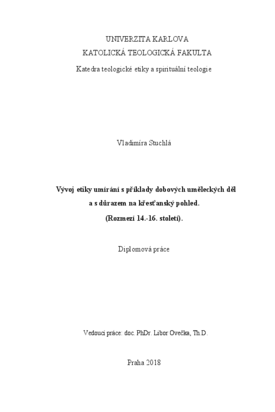Vývoj etiky umírání s příklady dobových uměleckých děl a s důrazem na křesťanský pohled.
History of ethics of dying with artworks examples accented on Christian perspectives.
diploma thesis (DEFENDED)

View/Open
Permanent link
http://hdl.handle.net/20.500.11956/104127Identifiers
Study Information System: 203761
Collections
- Kvalifikační práce [2343]
Author
Advisor
Referee
Ryšková, Mireia
Faculty / Institute
Catholic Theological Faculty
Discipline
Applied Ethics
Department
Department of Theological Ethics and Theology of Spirituality
Date of defense
4. 9. 2018
Publisher
Univerzita Karlova, Katolická teologická fakultaLanguage
Czech
Grade
Good
Keywords (Czech)
ars moriendi,Bible,carpe diem,černá smrt,eschatologie,flagelanti,macabrózní umění,memento mori,tance smrti,vanitasKeywords (English)
Ars moriendi, Bible, carpe diem,pestilemce,eschatpology,flagellant,macabre art, dying memento mori,death dances, vanitasVývoj etiky umírání s příklady dobových uměleckých děl a s důrazem na křesťanský pohled. (Rozmezí 14.-16. století). Východiskem této práce je stručný popis eschatologie, rozvíjející se v rámci křesťanské etiky v průběhu morové apokalypsy pozdního středověku. Stěžejní část práce je zaměřena na změny individuálního i společenského vnímání smrti během velmi náročného období výrazné vlny morové epidemie pozdního středověku až raného novověku. Jsou sledovány záměny v přístupu a vyrovnávání se s atributem smrti. Cílem práce je shromáždit, analyzovat změny pojetí smrti během sledovaného období, zhodnotit jejich vliv na chování člověka prostřednictvím potvrzení či zamítnutí nastolených hypotéz. Dostupné materiály jsou doplněny náhledy dobové umělecké tvorby ztvárňující postoje člověka dané doby ke vnímání vlastní konečnosti. Klíčová slova Ars moriendi, Bible, carpe diem, černá smrt, eschatologie, flagelanti, macabrózní umění, memento mori, tance smrti, vanitas.
The development of ethics with samples of period fine art pieces with the emphasis on Christian view. (Range 14.-16. century). The base of this thesis is a brief description of eschatology, developing in the frame of Christian ethics in the midstream of the pestilence's apocalypse of the late Middle Ages. The main part of the thesis is focused on changes in individual as well as social perception of death during the very demanding era of extreme wave of pestilence's epidemic in late Middle Ages even early modern history. The changes in approach and coping with the attribute of death are being observed. The aim of the thesis, on the basis of literary studies, is to gather and analyze the changes in interpretation of death during the mentioned period, evaluate their influence of people's behavior by verification or denial of given hypothesis. The accessible materials are supplemented by previews of period fine art pieces showing the attitude of people in given era towards the perception of their own death. Key words Ars moriendi, Bible, carpe diem, pestilence, eschatology, flagellant, macabre art, dying memento mori, death, death dances, vanitas.
